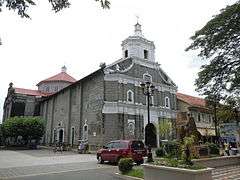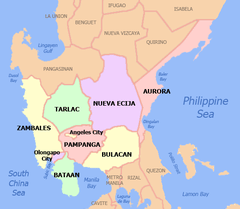Gapan
Gapan, officially the City of Gapan (Tagalog: Lungsod ng Gapan), is a 4th class city in the province of Nueva Ecija, Philippines. According to the 2015 census, it has a population of 110,303 people.[4]
Gapan | |
|---|---|
| City of Gapan | |
    (From top, left to right): La Divina Pastora Gapan City Welcome Monument • Primark Center • Downtown Gapan • La Divina Pastora National Shrine • Gapan City Hall | |
 Seal | |
| Nickname(s): Tsinelas capital of the Philippines | |
 Map of Nueva Ecija with Gapan highlighted | |

| |
.svg.png) Gapan Location within the Philippines | |
| Coordinates: 15°18′27″N 120°56′43″E | |
| Country | |
| Region | Central Luzon (Region III) |
| Province | Nueva Ecija |
| District | 4th District |
| Founded | 1732 |
| Cityhood | August 25, 2001 |
| Barangays | 23 (see Barangays) |
| Government | |
| • Type | Sangguniang Panlungsod |
| • Mayor | Emerson D. Pascual |
| • Vice Mayor | Inocencio T. Bautista Jr.[2] |
| • Congressman | Maricel N. Nagaño |
| • Electorate | 87,678 voters (2019) |
| Area | |
| • Total | 118.00 km2 (45.56 sq mi) |
| Elevation | 25.6 m (84.0 ft) |
| Population (2015 census)[4] | |
| • Total | 110,303 |
| • Density | 930/km2 (2,400/sq mi) |
| • Households | 24,586 |
| Demonym(s) | Gapanueño (Male), Gapanueña (Female), Gapanuenean |
| Economy | |
| • Income class | 4th city income class |
| • Poverty incidence | 14.55% (2015)[5] |
| • Revenue (₱) | 481,188,389.06 (2016) |
| Time zone | UTC+8 (PST) |
| ZIP code | 3105 |
| PSGC | |
| IDD : area code | +63 (0)44 |
| Climate type | tropical monsoon climate |
| Native languages | Kapampangan Tagalog Ilocano |
| Website | www |
Gapan is nicknamed the "Footwear Capital of the North" due to the thriving footwear making industry in the city.
History
Old records called the town Ibon. Gapan was founded by the Spanish curates and officials who, in their early occupation, exercised great influence over the people and the things they were doing. History places Gapan as one of the first towns of Pampanga founded sometime in the middle part of the sixteenth century. Records of the first Catholic mission to the far east indicated that in 1595, Fathers Contres Tendilla, Caballo and Salazar were responsible for clearing the forest which later became a pueblo. In this pueblo, a church, presedencia and residential houses made of bricks and lime were constructed, now the age-old landmarks of the city.
Its foundation in 1595 makes Gapan the oldest town in Nueva Ecija and one of the oldest in the Philippines. It was likewise a big pueblo embracing an area as far as Cabanatuan City in the north, which was its barrio with the name Cabanatuan before it separated in 1750: the Sierra Madres in the East, San Miguel, Bulacan in the south and Candaba, Pampanga in the West. Gradually as the Spanish power waned and economic progress caught up in the area, the pueblo disintegrated into many pueblos until it remained to comprise only the towns of Peñaranda, General Tinio and San Leonardo (formerly called Manikling) all of Nueva Ecija province. In fact the Patron Saint Divina Pastora had its origin or residence in Barrio Callos, Peñaranda.
Contemporary
By virtue of Republic Act No. 9022 and its ratification in a plebiscite subsequently held on August 25, 2001, Gapan was converted into a component city of Nueva Ecija. Ernesto L. Natividad became the first city mayor of Gapan.
Geography
Gapan is located in the southern part of the province. It is bounded to the north by Peñaranda and San Leonardo, to the east by the Gen. Tinio, to the south by San Miguel in neighboring Bulacan province, and to the west by San Isidro.
Climate
| Climate data for Gapan City, Nueva Ecija | |||||||||||||
|---|---|---|---|---|---|---|---|---|---|---|---|---|---|
| Month | Jan | Feb | Mar | Apr | May | Jun | Jul | Aug | Sep | Oct | Nov | Dec | Year |
| Average high °C (°F) | 28 (82) |
30 (86) |
31 (88) |
33 (91) |
33 (91) |
31 (88) |
30 (86) |
29 (84) |
29 (84) |
30 (86) |
30 (86) |
29 (84) |
30 (86) |
| Average low °C (°F) | 20 (68) |
20 (68) |
20 (68) |
22 (72) |
24 (75) |
24 (75) |
24 (75) |
24 (75) |
24 (75) |
23 (73) |
22 (72) |
21 (70) |
22 (72) |
| Average precipitation mm (inches) | 4 (0.2) |
4 (0.2) |
5 (0.2) |
11 (0.4) |
66 (2.6) |
99 (3.9) |
127 (5.0) |
113 (4.4) |
99 (3.9) |
84 (3.3) |
35 (1.4) |
14 (0.6) |
661 (26.1) |
| Average rainy days | 2.2 | 1.9 | 3.2 | 5.3 | 16.1 | 20.8 | 23.5 | 22.8 | 22.2 | 16.5 | 8.9 | 3.5 | 146.9 |
| Source: Meteoblue [6] | |||||||||||||
Barangays
Gapan is politically subdivided into 23 barangays.
- Balante
- Bayanihan
- Bulak
- Bungo
- Kapalangan
- Mabuga
- Maburak
- Macabaklay
- Mahipon
- Malimba
- Mangino
- Marelo
- Pambuan
- Parcutela
- Puting Tubig
- San Lorenzo
- San Nicolas
- San Roque
- San Vicente
- Santa Cruz
- Santo Cristo Norte
- Santo Cristo Sur
- Santo Niño
Demographics
| Population census of Gapan | |||||||||||||||||||||||||||||||||||||||||||||||||
|---|---|---|---|---|---|---|---|---|---|---|---|---|---|---|---|---|---|---|---|---|---|---|---|---|---|---|---|---|---|---|---|---|---|---|---|---|---|---|---|---|---|---|---|---|---|---|---|---|---|
|
| ||||||||||||||||||||||||||||||||||||||||||||||||
| Source: Philippine Statistics Authority[4][7][8][9] | |||||||||||||||||||||||||||||||||||||||||||||||||
Economy
Current major sources of income include farming, slipper making, fishponds, poultry and piggery, and commercial establishments.
The city of Gapan held tremendous promise not only in its natural resources but also in its potentials in agri base industries and in footwear industries which help sustain its virtual role in agricultural and industrial production. Commercial and trade activities in the city are further accelerated by the influx of financing lending institution and new businesses.
Places of interest

- National Shrine of Virgen La Divina Pastora
- The center of Marian pilgrimages during the months of April and May is the National Shrine of Virgen La Divina Pastora as declared by the Catholic Bishops Conference in 1986.
Colleges in Gapan City
- Divina Pastora College
- Asian Institute of E-commerce (AIE) - Gapan Campus
- Gapan Computer Technical Institute
- ACLC College (Gapan Campus)
- Allen Institute of Technology
- College for Research and Technology
- Nueva Ecija University of Science and Technology – Gapan Academic Extension Campus
- Gapan City Technical School
- Provincial Manpower Training Center (Technical School)
- SKD Academy Gapan Campus
Health care
- Good Samaritan General Hospital - a private hospital located at Don Simeon St, Gapan City.
- Gapan District Hospital - a public hospital located at Divina Pastora Street, Divina Pastora Subdivision, Gapan City.
- Dr. J.P. Cruz Cancer Clinic
- other clinics (dental, skin and etc..)
Notable people of Gapan
- Mariano Llanera, the Revolutionary General of the battle Cry of Nueva Ecija in Cabiao, Nueva Ecija.
- General Pantaleon Valmonte, the capitan municipal of Gapan who, together with General Mariano Llanera, capitan municipal of Cabiao, launched the "First Cry of Nueva Ecija" against the Spanish rule on September 2, 1896.
- Juan Liwag - former Senator of the Philippines
- Nida Blanca - award-winning actress
- Ryza Cenon[10] - actress
- Eula Valdez[11] - actress
- Joe Taruc[12] - DZRH news anchor
- Frankie Evangelista Former TV Patrol News Anchor
- Coleen Perez - actress
- Daniel Figueroa[13] - actor
- Deo Macalma - Radio and Television Anchor MBC and DZRH
Sister cities
- Cabanatuan City, Nueva Ecija
- Cabiao, Nueva Ecija
Images
- Rice fields, Santo Cristo
- City Hall
- City park
 Wet market
Wet market- Dry Market and the Water District
- Cockfighting Coliseum
References
- "City". Quezon City, Philippines: Department of the Interior and Local Government. Retrieved May 30, 2013.
- http://www.pcoo.gov.ph/dir-lgu-citymayors.htm
- "Province: Nueva Ecija". PSGC Interactive. Quezon City, Philippines: Philippine Statistics Authority. Retrieved November 12, 2016.
- Census of Population (2015). "Region III (Central Luzon)". Total Population by Province, City, Municipality and Barangay. PSA. Retrieved June 20, 2016.
- "PSA releases the 2015 Municipal and City Level Poverty Estimates". Quezon City, Philippines. Retrieved January 1, 2020.
- "Gapan: Average Temperatures and Rainfall". Meteoblue. Retrieved May 4, 2020.
- Census of Population and Housing (2010). "Region III (Central Luzon)". Total Population by Province, City, Municipality and Barangay. NSO. Retrieved June 29, 2016.
- Censuses of Population (1903–2007). "Region III (Central Luzon)". Table 1. Population Enumerated in Various Censuses by Province/Highly Urbanized City: 1903 to 2007. NSO.
- "Province of Nueva Ecija". Municipality Population Data. Local Water Utilities Administration Research Division. Retrieved December 17, 2016.
- http://www.pinoystop.com/bio/celebrity-profile/1204/ryza-cenon-biography
- http://www.lakadpilipinas.com/2015/07/gapan-ancestral-houses-church.html
- http://www.lakadpilipinas.com/2015/07/gapan-ancestral-houses-church.html
- https://www.pep.ph/news/143340/former-actor-daniel-figueroa-passes-away-a734-20190517
External links
| Wikivoyage has a travel guide for Gapan. |
| Wikimedia Commons has media related to Gapan City. |
